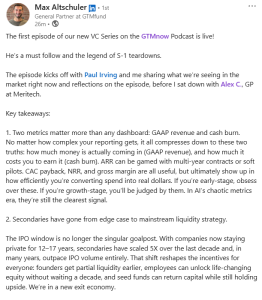
“We are expected to fuel business growth and innovation, yet to do so with constrained resources, increasing complexity and on faster timelines.”
This quote — shared by Zach Hoogerland, senior director of marketing operations and analytics at Rubrik — at MOps-Apalooza summarizes what it means to work in marketing operations today.
This year marked the third — and sadly, final — edition of MOps-Apalooza (in its current format), a marketing operations conference hosted by MarketingOps.com and members of the MO Pros community. Held in Anaheim, Calif., the event brought together nearly 500 in-person attendees and another 200 online, all eager to explore how technology, data and strategy can be optimized to drive business growth.
“For the first time in our annual research report, the top success measure for a marketing operations professional has now shifted from pipeline as a core measure and a KPI to our ability to create operational enablement and scalability,” said Mike Rizzo, CEO of MarketingOps.com.
Rizzo remarked that MOps professionals are measured by their ability to empower go-to-market (GTM) teams to succeed — helping them drive ROI from their tech stack and execute efficiently at scale.
In other words, the role is less centered around producing immediate outputs and more about building the infrastructure that will foster sustained growth.
Dig deeper: 5 ways MOps can stop order-taking and start driving strategy
How AI will impact the field of marketing operations
As you might expect, AI was another recurring theme at the conference.
In the opening keynote, Audrey Harze, CMO at MarketingOps.com, noted that “AI is not the experiment anymore; it is the expectation.” Rizzo added that we are entering an era where “tech is moving faster than strategy.”
However, the work of marketing operations professionals is too nuanced to be replaced by AI. As Rizzo explained, AI can “see success stories,” but not the complexity behind them.
Marketing operations is a dynamic field, where success depends on various factors, including the industry, company size and tech stack where you’re operating, to name a few. Each organization has its own carefully configured systems and workflows that enable it to accomplish specific business goals. This high variability makes it
impossible for AI to replicate the role entirely. Human judgment remains an invaluable part of the GTM process.
But AI can still be an essential asset if appropriately leveraged. AJ Navarro, marketing operations manager at Sprout Social, reminded attendees that “AI doesn’t replace people — it replaces the processes that slow them down.”
Some teams are already using AI to streamline repetitive tasks such as webinars, internal documentation, email automations and marketing reports. Several speakers at MOps-Apalooza cautioned that relying on AI for content creation or campaign strategy risks diluting effectiveness.
MOps professionals must therefore learn to prompt effectively, define clear guardrails and integrate AI strategically to reduce tedium. That said, some tasks must stay in human hands to prevent sacrificing creativity and authenticity.
Dig deeper: Why the future of marketing depends on a smarter MOps function
More scale, but more noise
As technology advances and tools become more accessible, scalability increases, but so has the noise. Nancy Chou, senior vice president of growth at Belkins, shared that engagement rates for cold outreach dropped from 15% in 2018 to 7.5% in 2022 and are now at just 3%.
This decline emphasizes the need for more unique, human-centered engagement strategies. Some speakers discussed optimizing outreach schedules and using AI to emulate human connection in nurturing relationships. But to do so, AI must be trained carefully to ensure brand voice, personalization and relevance remain intact.
There are still no precise metrics to measure how AI is perceived, and its effectiveness is only as strong as the quality of its input. As one speaker advised, “AI doesn’t have to be the answer to everything.”
Thus, out-of-the-box strategies may need to be implemented. For example, Chou suggested that sales development representatives (SDRs) be more closely integrated into marketing and client-nurturing efforts.
The C-suite gap and advocacy
Another recurring theme at MOps-Apalooza was the disconnect between marketing operations teams and the C-suite. Executives often focus on outcomes — pipeline growth, ROI, campaign performance — without acknowledging the operational rigor and arduous experimentation that occur behind the scenes.
As one attendee remarked, “Leaders don’t need to know every process detail — they just need to see the impact.”
Thus, MOps professionals must learn to translate their technical processes into business impact. Technology and automation are not instant fixes; behind every workflow lies deep strategic thinking, cross-functional collaboration and creative problem solving. Yet, the work of marketing operations often goes unnoticed until something goes wrong. Recognizing and communicating this value is crucial for sustaining investment and driving evolution in the field.
Why the MOps community matters
For many, MOps-Apalooza was more than a learning event. It was a community moment. In a field where professionals often work with leaders who are not as operationally minded, it was refreshing to be surrounded by peers who truly understand and value the complexity of the work.
Knowledge sharing in marketing operations is not something that can be easily learned from a single book or lecture. It’s dynamic and context-dependent. Events like MOps-Apalooza allow professionals to exchange ideas, compare processes and bring new insights back to their organizations.
As AI accelerates, creativity and strategic thinking — the very qualities that define great MOps professionals — become increasingly valuable. The consensus among attendees was clear: as technology advances, human insight becomes increasingly essential.
Marketing operations is not just about managing systems and running automations — it is about translating business goals into actionable steps and engineering clarity out of chaos. It is a discipline that balances data, creativity and strategy to keep organizations running smoothly behind the scenes.
As Rizzo and Harze stated, “AI doesn’t change the game. MOps does. We don’t adopt the future. We design it. And this community is doing it together. We are building the bridges that every great business needs.”
The post MarketingOps redefines success for the age of AI appeared first on MarTech.



















